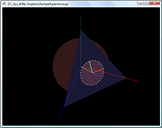Simple visualization using pyglet & pyeuclid (Python)
Posted: Sat Nov 06, 2010 7:03 pm
It would seem natural to me to involve C++, OpenGL, GLUT and a linear algebra package e.g. GML, when in comes to visualizing a geometric problem. However, I’ve recently tried a more straightforward way to do this using pyglet and pyeuclid. There’s a significant boost in productivity using these Python-based tools, especially when it comes to small, kind of engineering tasks. I’ve managed to code the whole problem in just 2 hours with no surprises (incl. environment setup, without previous experience!), something totally impossible using the native approach, and there’s a bonus as well – it runs seamlessly on booth Windows and OSX.
Here's the result:


VIEW THE CODE BELOW IN FULL-SCREEN (pyglet_pyeuclid_visualization_sample.py)
Here's the result:


VIEW THE CODE BELOW IN FULL-SCREEN (pyglet_pyeuclid_visualization_sample.py)
Code: Select all
#!/usr/bin/env python
# /*
# (c) 2010 +++ Filip Stoklas, aka FipS, http://www.4FipS.com +++
# THIS CODE IS FREE - LICENSED UNDER THE MIT LICENSE
# ARTICLE URL: http://forums.4fips.com/viewtopic.php?f=3&t=198
# */
from euclid import Vector3
from euclid import Matrix4
from math import sqrt
from pyglet.gl import *
from pyglet.gl.glu import *
def draw_line(p1, p2, color, width=1):
glLineWidth(width)
glColor4f(color[0], color[1], color[2], 1)
glBegin(GL_LINES)
glVertex3f(p1[0], p1[1], p1[2])
glVertex3f(p2[0], p2[1], p2[2])
glEnd()
def draw_coords(mtx, size, width=1):
x = Vector3(size, 0, 0);
y = Vector3(0, size, 0);
z = Vector3(0, 0, size);
orig = mtx[12:15]
draw_line(orig, orig + mtx * x, (1, 0, 0), width)
draw_line(orig, orig + mtx * y, (0, 1, 0), width)
draw_line(orig, orig + mtx * z, (0, 0, 1), width)
def draw_sphere(radius, color, alpha):
glEnable(GL_BLEND)
glBlendFunc(GL_SRC_ALPHA, GL_ONE_MINUS_SRC_ALPHA)
glColor4f(color[0], color[1], color[2], alpha);
sphere = gluNewQuadric()
gluSphere(sphere, radius, 50, 50)
glDisable(GL_BLEND)
def draw_triangle(p1, p2, p3, color, alpha):
glEnable(GL_BLEND)
glBlendFunc(GL_SRC_ALPHA, GL_ONE_MINUS_SRC_ALPHA)
glColor4f(color[0], color[1], color[2], alpha)
glBegin(GL_TRIANGLES)
glVertex3f(p1[0], p1[1], p1[2])
glVertex3f(p2[0], p2[1], p2[2])
glVertex3f(p3[0], p3[1], p3[2])
glEnd()
glDisable(GL_BLEND)
window = pyglet.window.Window()
@window.event
def on_resize(width, height):
glViewport(0, 0, width, height)
glMatrixMode(GL_PROJECTION)
glLoadIdentity()
gluPerspective(45, width / float(height), .1, 1000)
gluLookAt(
1, 4, 3, # eye
0, 0, 0, # target
0, 1, 0 # up
);
glMatrixMode(GL_MODELVIEW)
return pyglet.event.EVENT_HANDLED
@window.event
def on_draw():
a = 1.6
b = a * sqrt(3) / 3
r = sqrt(1 - b*b)
R = Vector3(a, a, a).normalized() * b
cs = Matrix4.new_translate(R[0], R[1], R[2]) * Matrix4.new_look_at(Vector3(0, 0, 0), R, Vector3(0, 1, 0))
glDisable(GL_DEPTH_TEST)
glClear(GL_COLOR_BUFFER_BIT | GL_DEPTH_BUFFER_BIT)
glLoadIdentity()
draw_coords(Matrix4.new_identity(), 2)
draw_line((0, 0, 0), R, (1, 1, 0))
draw_coords(cs, r, 3)
glEnable(GL_DEPTH_TEST)
draw_triangle((a, 0, 0), (0, a, 0), (0, 0, a), (.5, .5, 1), .2)
draw_sphere(1, (1, .5, .5), .2)
pyglet.app.run()